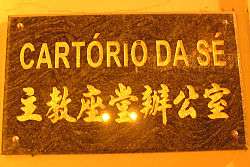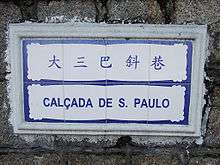Portuguese language in Asia
The Portuguese language is spoken in Asia by small communities either in regions which formerly served as colonies to Portugal, notably Macau and East Timor where the language is official albeit not widely spoken, Lusophone immigrants, notably the Brazilians in Japan or by some Afro-Asians and Luso-Asians. In Larantuka, Indonesia and Daman and Diu, India, Portuguese has a religious connotation, according to Damanese Portuguese-Indian Association, there are 10 – 12,000 Portuguese speakers in the territory.[1]
Geographic distribution


- Sri Lanka: Formerly known as Ceylon (Ceilão in Portuguese), the island's first European visitors were Portuguese people, who gave the island its original name. The island is home to a Portuguese Burgher minority who speaks Sri Lankan Portuguese Creole. Sri Lanka participated in the Jogos da Lusofonia in 2006 and 2014.
- India: The state of Goa was a part of the Portuguese Empire until 1961. India participated in the Jogos da Lusofonia in 2006 and 2014. Goa is awaiting the permission of the Indian Government to join the CPLP as an observer.[3] In Goa, most of the relatively few speakers of Portuguese are older people. The Union Territory of Daman and Diu was also part of Portuguese India. As in Goa, the dwindling number of Portuguese speakers are also older people. Daman and Diu are also home to Indo-Portuguese Creoles. It is estimated that there are 3% – 5% of fluent speakers of Portuguese in Goa, Daman and Diu. The language is still spoken by about 10,000 people, in 2014, an estimated 1,500 students were learning Portuguese in Goa.[4]
- Malaysia and Singapore: The Malaysian state of Malacca and city-state of Singapore are homes to the Gente Kristang a community of Eurasians who claim Portuguese descent and speak Papia Kristang, a Portuguese-lexified Creole. The Portuguese settlement at Malacca is a source of tourism for the state and the Lusophone heritage is visible in cuisine, architecture and folklore of the Kristang people. Pending approval from the Malaysian Government, Malacca may join the CPLP as an associate observer.
- Macau: Portuguese is a co-official language alongside Chinese in the Chinese special administrative region of Macau. It has become the centre for Portuguese learning in Asia and has become the focus through which China relates diplomatically to the member states of CPLP. Macau was the host city for the first Lusophone games in 2006. While the Macanese Language is by now critically endangered with less than a hundred speakers, the number of speakers of Portuguese has also decreased since the handover in 1999. But enrollments for private Portuguese classes have tripled, to 1,000, since 2002; that prompted public schools here to offer Portuguese, drawing more than 5,000 students.[5] It is now estimated that about 3% of the population speak Portuguese as their first language, while 7% professes fluency.[6]
- East Timor: The Southeast Asian country added Portuguese as an official language as it gained independence from Indonesia in 2002. According to a 2004 census, 36 percent of respondents said they had "a capability in Portuguese".[7] The inter-ethnic lingua franca, Tetum has a large number of loanwords derived from Portuguese making the latter relatively easy to learn for speakers of the former.
- Japan: As of 2005, there were approximately 302,000 Brazilians living in Japan.[8] This is the largest immigrant community after the Chinese and Korean communities. This 'return migration' to Japan has resulted in the largest Portuguese-speaking community in Asia.
CPLP
Various regions in Asia have expressed interest in participating in the Community of Portuguese-speaking Countries (the CPLP). The Malaysian state of Malacca, Macau, and the Indian state of Goa have all applied for observer or associate member status and are awaiting the permission of the Malaysian, Chinese, and Indian governments, respectively. East Timor joined the CPLP shortly after its independence at the turn of the 21st century. Indonesia has also expressed interest in joining the CPLP.
Instituto Camões
The Instituto Camões maintains language centres in Macau, Goa, Busan and Dili.
Local norms and phonology
In Asia, Standard European Portuguese (português-padrão) forms the basis for the written and spoken norm, exclusively to East Timor and Macau.[9][10][11]
See also
- East Timorese Portuguese
- Goan Portuguese
- Macau Portuguese
External links
- Issues of Asian Portuguese-Speaking Spaces and Lusotopias
- Is There One Goan Identity,Several or None?
- Papia, Relijang e Tradisang The Portuguese Eurasians in Malaysia : Bumiquest, A Search for Self Identity
- The Portuguese Cultural Imprint on Sri Lanka
- China’s Portuguese Connection
- Talking Portuguese: China and East Timor
- As Maravilhas de Portugal no Mundo – Fortaleza de Damão, Índia
- As Maravilhas de Portugal no Mundo – Basílica do Bom Jesus de Goa
References
- https://archgoadaman.com/about-the-archdiocese/
- Carvalho, Daniela de (1 February 2013). "Migrants and Identity in Japan and Brazil: The Nikkeijin". ISBN 978-1-135-78765-3. Cite journal requires
|journal=(help) - "CPLP: Galiza com estatuto de observador associado só com "sim" de Madrid – Notícias Lusa – Sapo Notícias". Noticias.sapo.pt. Archived from the original on February 21, 2009. Retrieved 2010-07-29.
- "1.500 pessoas estudam português em Goa". Revistamacau.com. 2 June 2014. Retrieved 10 July 2015.
- China Sees Advantages in Macao's Portuguese Past, New York Times, October 21, 2004
- Leach, Michael (2007), "talking Portuguese; China and East Timor", Arena Magazine, retrieved 2011-05-18
- A New Country’s Tough Non-Elective: Portuguese 101, Seth Mydans, New York Times, July 31, 2007
- "Filhos de dekasseguis: educação de mão dupla". (Archive). Centenário da Imigração Japonesa: 100 anos de histórias. Museu Histórico da Imigração Japonesa no Brasil. "Segundo dados do Ministério da Justiça do Japão, em 2005, havia 302 mil brasileiros morando no país, além de 26 mil com dupla nacionalidade. Todo ano, cerca de 4 mil deles retornam para o Brasil."
- https://www.southeastasianarchaeology.com/2012/01/25/the-portuguese-in-southeast-asia/
- "Archived copy". Archived from the original on 2019-07-02. Retrieved 2019-07-02.CS1 maint: archived copy as title (link)
- In Macau, the official spelling of the Portuguese language is fixed by Decree-Law No. 103/99/M